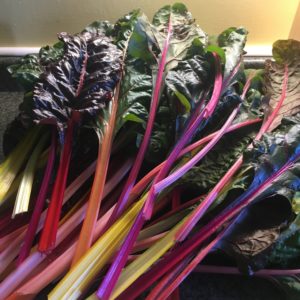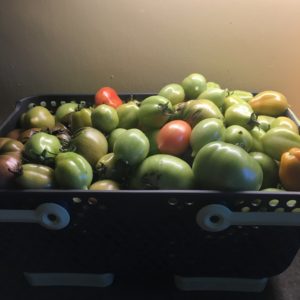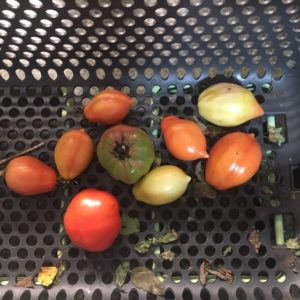
It may be that I’m in a tiny minority that doesn’t look at January 1 as the beginning of a new year. Perhaps because I’ve followed an academic calendar for almost the entirety of my working life, I find more resonance in September when classes start or, as a gardener, when the first seeds or transplants go into the ground. This is by way of saying this post is not about new beginnings or new year’s resolutions (which I never make. If you’re going to resolve to do something, do it immediately while the motivation is strong. Those are the only ones of mine that seem to stick anyway.) but time for a certain degree of reflection–the final 2019 garden installment. It’s not even particularly late to do so, as I’m still eating the last of the tomatoes that I brought in right before the first frost on November 3rd. So let’s get to it.
First, I am shocked that the last garden posting was in May. Some family concerns and grad school combined to make both my blogging and garden time somewhat limited. But nature will have its way and, once started, things took off with minimal input from me. We had a very wet spring, dry midsummer, and soggy fall, which made for an interesting season and cracked tomatoes, the result of uneven watering.



I plant a fairly unchanging selection of vegetables each year but will try different varieties within those categories. Because the fantastic Troy Farmers Market is within walking distance of me and it runs all year around, that dictates what I choose to have outside the back door. Every year there are perennial chives, lavender, sorrel, lovage, raspberries, and blueberries. Each spring into the ground go beets, radishes, turnips for my downstairs neighbor, peas, scallions, basil, parsley, cilantro, beans, zucchini, pickling and slicing cucumbers, kale, Swiss chard, red-leaf, romaine, and butter head lettuces, arugula, mesclun, and plum, cherry, and slicing tomatoes.
Peas are one of my favorite vegetables to have in the garden. They are among the first seeds in the garden, as they love the chilly early spring. Once picked, they start to turn starchy so having them just outside the back door means they can be eaten when they are best, right out of the garden. This year produced a bumper crop, trying several different varieties. I managed to keep the birds at bay, as they love the tender pea shoots and will snap the ends right off to eat, and two varieties towered over the pea fence used for support. Managed to have enough to get some in the freezer for winter soups. I tried a fall planting but, with grad classes and full-time work, wasn’t able to keep them well enough watered to get them going.
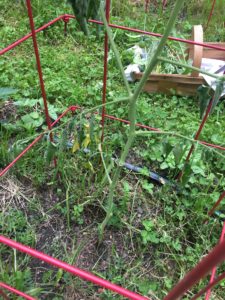
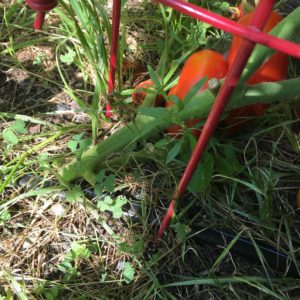
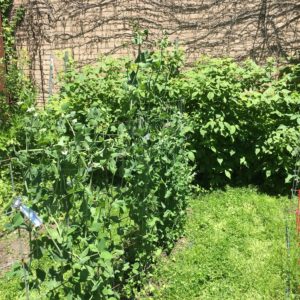
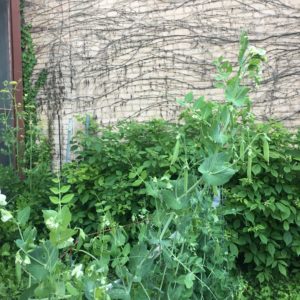
A truth about gardening—it’s never the same year twice and there’s always something to learn. This year the tomato seedlings were strapping specimens, started inside as usual but I made sure to pot them up to larger soil blocks (see Unlocking the Garden from April), which really developed strong, sturdy stems. I mentioned that we had a wet spring and, while most of my tomatoes continued to thrive, a few struggled and looked perennially wilted. Considering the amount of rain we had (I didn’t turn on my drip watering system for the first time until July!), it seemed counter-intuitive but I dutifully watered them more with no success. A little research turned up a condition called water wilt, which can’t be salvaged—and there went four plants. The remaining plants were robust (“Towering like sequoias,” I crowed) until they became laden with fruit and then the stems accordioned into a heap from lack of support. I use fabulous tomato cages from Gardeners Supply but only figured out this year that the plants need to be tied to the cages to redistribute the weight. I don’t know why that’s never occurred to me before. Another lesson learned for future seasons.
August garden
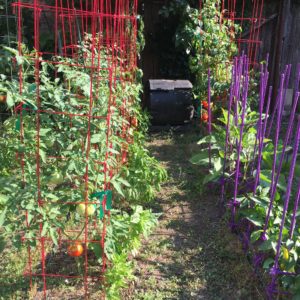


Raspberries were abundant this year and I was thrilled. It was really the first year that I got the full benefit of this variety that fruits in spring and fall. (see description in Unlocking the Garden from April). I let the new growth run wild this year to understand how they would grow and will do some hard pruning this coming year. The weaker canes don’t produce anything but tangles and weight on my DIY-trellising so I’ll be much more ruthless this coming year. I will, however, have a bounty of second-season canes that will bear fruit in the spring. I had the fall crop of raspberries producing at full tilt until the first hard frost in November. The only hiccup was keeping up with production!

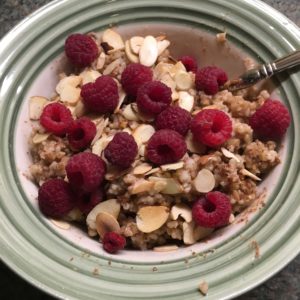
September is really when the garden seems to pull out all the stops; perhaps sensing the the shorter days and winter closing in. I pulled in a lot during that month!
My cucumbers really struggled this year and I had very few pickling cukes, which is a shame because I grow them just to make refrigerator pickles all summer. Green beans that have been disappointing over the last few seasons went gangbusters this year; I switched from bush beans to pole beans and that made all the difference for reasons I do not understand. Tried a new variety of zucchini that is less vine and more bush, to conserve real estate, and that did reasonably well its first summer.
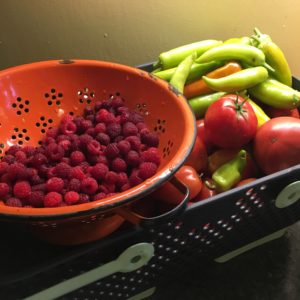
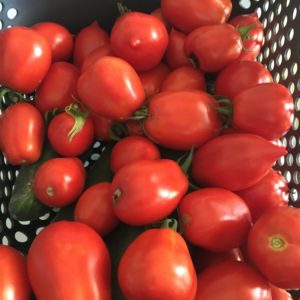
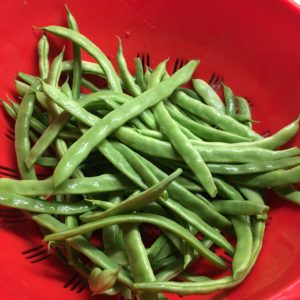

It may seem that this is a late update but I was pulling produce out of the back yard into November, and the first frost was only a little over a month ago. As I sit here and write this on New Year’s Day, I still have tomatoes ripening indoors that I pulled in green from the garden before the temperature dropped. Despite a period of neglect, the garden was happily productive, and I was able to put quite a bit away for the winter—but that’s a post for another day. The spring seed catalogues are arriving and soon I’ll be sorting through my seeds, making my garden plan, and dusting off my grow lights to get some seeds started. I love spending cold, wintry days dreaming of playing in the dirt.
